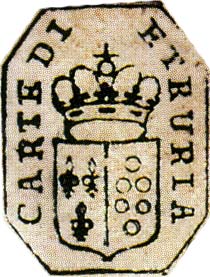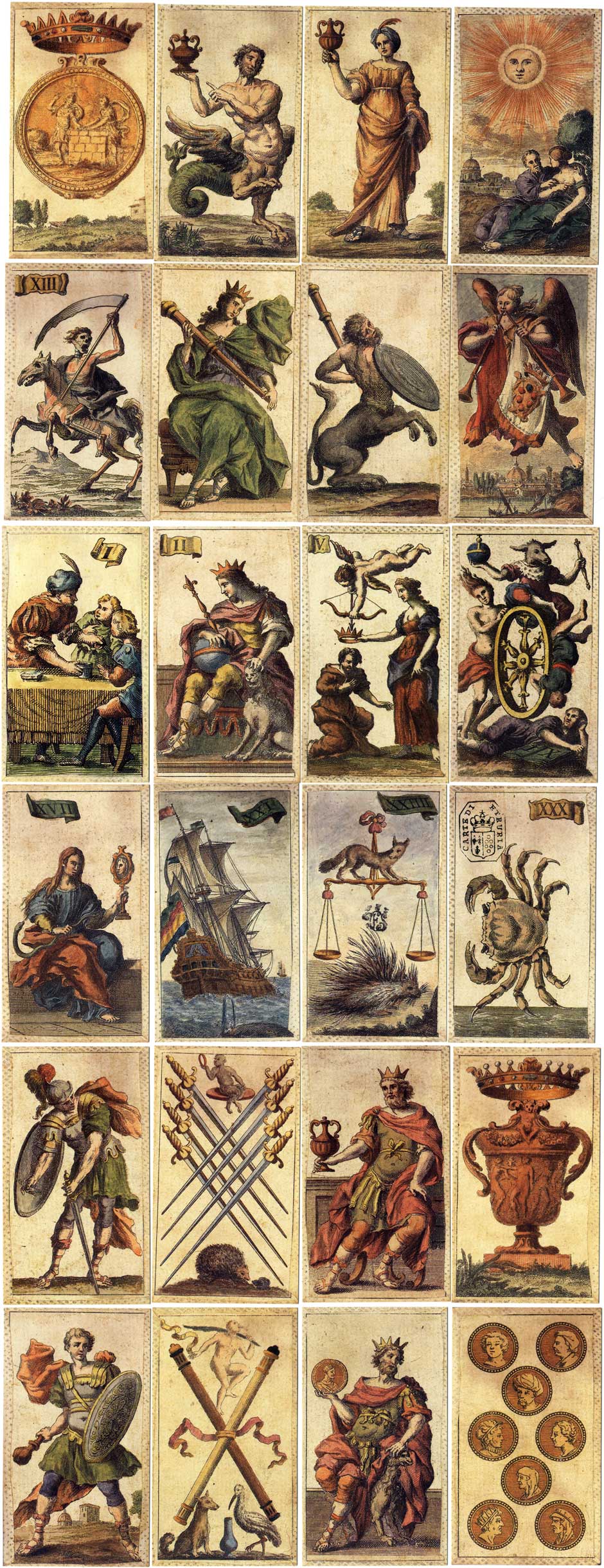Etruria Minchiate
The Cavaliers are man/beast creatures. The Valets (or Pages) are male for clubs and swords, and female for cups and coins.

Minchiate Etruria Card game, divination tool or teaching aid?
This antique “Minchiate Etruria” deck by Pietro Alligo was originally published in Florence in 1725, printed from copper plate etchings and hand coloured with water colours. Minchiate is a late-medieval card game employing a specially extended pack of 97 cards, related to tarot but including 12 zodiac signs, 4 virtues (faith, hope, charity, prudence) and 4 elements (fire, water, air, earth). The trump cards are untitled but are numbered with roman numerals in a scroll.
The game, like other Tarot games, is a trick taking game in which points are scored by capturing certain cards and sets of cards. However, the deck has also been popular with card readers who see it as a variant of the esoteric tarot because of the allegorical and symbolical content. The Cavaliers are man/beast creatures. The Valets (or Pages) are male for clubs and swords, and female for cups and coins. Further features include the replacement of the Papess, Empress and Pope by the Western Emperor, the Eastern Emperor and the addition of the Grand Duke. Some scholars believe that these cards may have served as teaching aids, because several trump allegories (Virtues, Elements, Zodiac signs) belong to categories upon which classical learning was based at that time.

Above: "Etruria" Florentine Minchiate deck, 97 cards, facsimile edition published by Il Meneghello, Milan, Italy, 1986 & 1994. Another edition was published by Lo Scarabeo in 1996. A stamp with the text 'CARTE DI ETRURIA' appears on trump number XXX 'Cancer', hence the name "Minchiate Etruria" used for this facsimile edition.
• See also: Tarocchi di Mantegna • Mitelli Tarocchini • Tarocchino Lombardo • Tarocco Neoclassico • Corona Ferrea Tarot • Matarelli Transformation.

By Simon Wintle
Member since February 01, 1996
Founder and editor of the World of Playing Cards since 1996. He is a former committee member of the IPCS and was graphics editor of The Playing-Card journal for many years. He has lived at various times in Chile, England and Wales and is currently living in Extremadura, Spain. Simon's first limited edition pack of playing cards was a replica of a seventeenth century traditional English pack, which he produced from woodblocks and stencils.
Related Articles

Lyon pattern made in Italy by Pietro de Santi
The Lyon pattern was initially developed in France during the 16th century. As Lyon was a trading hu...

Laurenzo Propagine
Spanish-suited cards made in Italy by Laurenzo Propagine.

Il Tarocco Mitologico
Fully pictorial Tarot designed by Amerigo Folchi with figures mainly from Greek mythology.

Neapolitan pattern by Luigi Pignalosa, Naples
Two versions of the Neapolitan pattern from the British Museum by Luigi Pignalosa, Naples, 1875 & 18...

Dylan Dog
Characters and objects from the Italian comic book series Dylan Dog, written by Tiziano Sciavi and d...

Royal Britain
Pack devised by Pietro Alligo depicting English monarchs from Alfred the Great to Elizabeth II.

Sevilla 1647 reproduction
Facsimile of Spanish-suited pack produced in Sevilla, Spain, 1647.

Le Monde Primitif Tarot
Facsimile edition produced by Morena Poltronieri & Ernesto Fazioli of Museo Internazionale dei Taroc...

I Tarocchi del Buongustaio
A less-than-serious set of major arcana on a gourmet theme, with designs by Cosimo Musio.

Poker Lusso
Richly costumed courts on a luxury poker pack from Masenghini.

Le Roi bridge
Reprint of a Piatnik (Budapest) pack of 1927 with Hungarian historical figures and scenic aces.

Pinocchio playing cards
Comic book drawings inspired by Carlo Collodi’s children’s classic, Pinocchio.

Le Ore playing cards
Caricatures of famous personalities from the late 1970s for the Italian magazine Le Ore.

Carte Romantiche Italiane
Scenes of life and the theatre in Milan towards the second half of the 19th century.

Lo Stampatore
‘Lo Stampatore’ linocut images created by Sergio Favret, published as a deck of cards by Editions So...

Leonardo collection
Leonardo collection playing cards with drawings from his notebooks.
Trending Articles
Popular articles from the past 28 days


